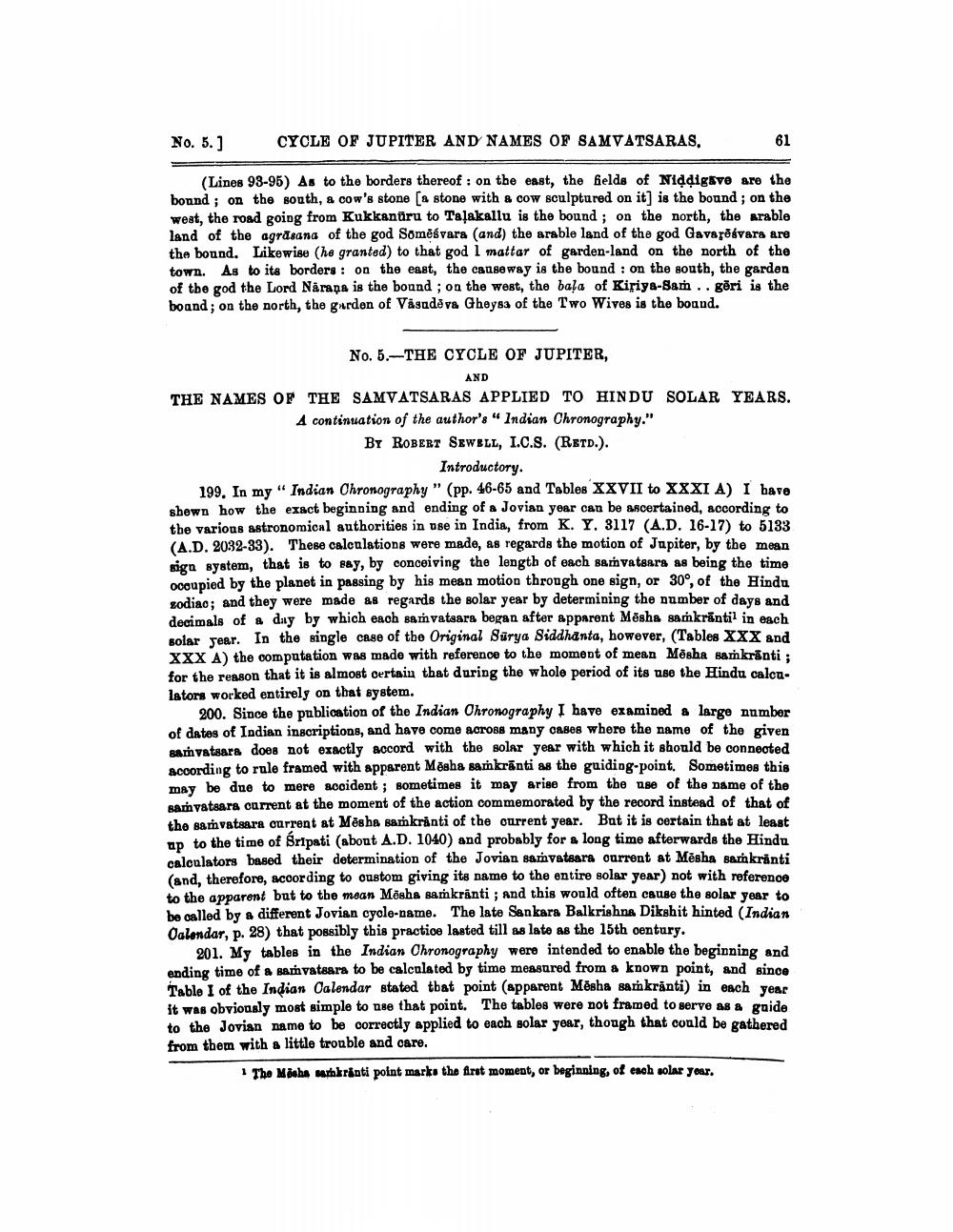________________
No. 5. ]
CYCLE OF JUPITER AND NAMES OF SAMVATSARAS.
61
(Lines 93-95) As to the borders thereof : on the east, the Gelds of Niddig ve are the bound; on the south, & cow's stone (s stone with a cow sculptured on it] is the bound; on the west, the road going from Kukkantru to Talakallu is the bound; on the north, the arable land of the agrasana of the god Somēśvara (and) the arable land of the god Gavaposvara are the bound. Likewise (he granted) to that god I mattar of garden-land on the north of the town. As to its borders : on the east, the causeway is the bound : on the south, the garden of the god the Lord Närapa is the bound; on the west, the bala of Kiriya-Sam.. gēri is the boand; on the north, the garden of Vågadeva Gheys3 of the Two Wives is the bound.
No. 5.-THE CYCLE OF JUPITER,
AND THE NAMES OF THE SAMVATSARAS APPLIED TO HINDU SOLAR YEARS.
A continuation of the author's "Indian Chronography." BY ROBERT SEWELL, I.C.S. (RETD.).
Introductory. 199. In my "Indian Chronography" (pp. 46-65 and Tables XXVII to XXXI A) I have shewn how the exact beginning and ending of a Jovian year can be ascertained, according to the various astronomical authorities in use in India, from K. Y. 3117 (A.D. 16-17) to 5133 (A.D. 2032-33). These calenlations were made, as regards the motion of Japiter, by the mean sign system, that is to say, by conceiving the length of each samvatsara as being the time oooupied by the planet in passing by his mean motion through one sign, or 30°, of the Hindu zodiac; and they were made as regards the solar year by determining the number of days and decimals of a day by which each samvatsara began after apparent Mēsha samkrāntil in each Bolar year. In the single case of the Original Sürya Siddhanta, however, (Tables XXX and XXX A) the computation was made with reference to the moment of mean Mosha sarnkrinti for the reason that it is almost certain that during the whole period of its use the Hindu calcalators worked entirely on that system.
200. Since the publication of the Indian Chronography I have examined a large number of dates of Indian inscriptions, and have come across many cases where the name of the given sarvatsara does not exactly accord with the solar year with which it should be connected scoording to rule framed with apparent Mēsba samkrānti as the guiding-point. Sometimes this may be due to mere accident; sometimes it may arise from the use of the name of the samvatsara current at the moment of the action commemorated by the record instead of that of the samvatsara current at Mēsha samkrinti of the current year. But it is certain that at least ap to the time of Sripati (about A.D. 1040) and probably for a long time afterwards the Hindu calculators based their determination of the Jovian samvatsara current at Měsha sankranti (snd, therefore, according to oustom giving its name to the entire solar year) not with reference to the apparent but to the mean Mosha sankranti ; and this would often cause the solar year to be called by a different Jovian cyole-name. The late Sankara Balkrishna Dikshit hinted (Indian Oalondar, p. 28) that possibly this practice lasted till as late as the 15th century.
201. My tables in the Indian Chronography were intended to enable the beginning and ending time of a samvatsara to be calculated by time measured from a known point, and since Table 1 of the Indian Calendar stated that point (apparent Měsha sankranti) in each year it was obviously most simple to use that point. The tables were not framed to serve as a gaide to the Jovian name to be correctly applied to each solar year, though that could be gathered from them with a little trouble and care.
The Misha wkranti point marks the first moment, or beginning, of each solar your.




